Final report for FNE18-909
Project Information
The purpose of this project was to evaluate the impact of pasture on the growth of pigs. In order to do that, we separated a homogeneous group of 15 animals in 3 subgroups, exposed to 2 different nutritional regimes: 1) grain concentrate feed only, confined in the barn (Barn group), 2) grain concentrate feed with integration of pasture (Pasture group) 3)grain concentrate feed with integration of pasture and crops (Pasture+). The main parameter that was monitored throughout the research (Aug 8th to Nov 5th) was the weight, measured weekly through an indirect formula that relates girth size and length to the actual weight. The crops chosen to improve the pasture in the third group (turnips and alfalfa) didn't perform well and therefore no difference between the two pastures was notable.
The weight in the two pasture groups was higher than in the confined group throughout the entire duration of the trial with the highest difference in weight (25 lbs) during the week prior to slaughter. A possible interpretation of the results could be given looking at the amount of grass consumed by the pigs on pastures: on average 370 lbs of dry matter were consumed by each pig. This lead on average to a higher intake of energy and protein, and possibly to a better growth rate.
This research, despite the great variability in the results, can be a good starting point for further in-depth analysis on pig grazing with a few adjustments for optimal results: a good protocol and more advanced tools to measure precisely the live weight and the adjustment of the forage values, so that they can be used for non ruminant animals.
Outreach for this project was done through farm visits and though a workshop in collaboration with Poultney Mettowee NRCD on how to raise pigs on pasture.
The objective was to determine how the nutritional value in a pasture is converted into meat for pastured pork. This information could translate into improved farm efficiency through a better use of feed, the primary cost in livestock operations. A more detailed understanding of pasture nutritional value, allows the farmer to be more planned in the amount of concentrated feed, with a consequent benefit in animal performance, economic costs and environmental cost related to grain production. We expected that pigs raised in the barn on a concentrated mix alone would be outperformed in growth rate from the pigs raised on pasture and concentrated mix.
A second objective was to maximize pig performance by increasing the amount of food the pigs harvest from our land. To this end, we tried to improve a pasture, adding crops - turnips and alfalfa. We wanted to determine if such improvement could further cut costs and energy related to harvest. Initially, we predicted that pigs rotated on the improved pasture would be fed 80% of the concentrated feed provided to the pigs raised in the barn and pigs raised on pasture. We were expecting that pigs on the improved pasture would outperform the pigs on a regular pasture and pigs raised in the barn.
The interaction between pastures and pigs have been studied very little in the past, mainly because pigs are not ruminants and therefore are not considered herbivores. By what we observed, pigs have the ability to utilize forage and convert it into meat, especially in case of adults animals.
The purpose of the project was to determine how much feed can be provided by forage and what are the effect on the animals in terms of growth and quality of the meat. There are many aspect of this way to manage pigs that can have an effect on sustainability of northeast farms: financially, since part of the daily energy and amino acids requirement is satisfied by grazing, there's a potential reduction in feed costs. From an environmental perspective, using pastures as a nutritional source means a lower reliance on external inputs and so a lower carbon footprint. In addition, the rotational plans can lead to healthier and more productive soil and a lower concentration of nitrates in manure pits or piles, and therefore a reduction in the potential for water pollution and carbon costs related to manure spreading. From the perspective of animal welfare, raising pigs on pastures promotes a stronger immune system and therefore less need for medications. Pastured pigs also can engage in greater exercise, leading to leaner meat, and have the ability to express natural animal behavior.
The project was important to our farm because highlighted the benefits of raising pigs on pasture and allowed us to increase our knowledge on forage production specific for pigs. The goal of Agricola farm is to raise 100% of the pigs (approximately 140 per year) outside during the grazing season using the practices applied in this project. For us, this means more time spent with the animals and more time dedicated to rotations, but less time spent on manure handling and spreading, less need for medication, happier and healthier animals. Moreover, a reduction in feed cost and potentially an improvement in the quality of our meat. These practices can be used by other farmers without the need of big additional costs and can approachable by any farmer who wants to produce meat sustainably.
Agricola farm began in Panton in 2014. We are a small (60 acres) diversified farm that raises animals for meat, in specific pork and lamb meat.
We raise on average 130-140 pigs year of which 90-100 are grazed in rotations on pasture from May to November. We size our paddocks according to the number and size of animals and we let them graze only once the same paddock. In this way, we preserve the health of our soil and limit damage due to the natural behavior of the pigs. Once the grass stand is fully regrown, we pass the sheep through the paddocks once, generally towards the beginning of September.
At age of 12+ months, our pigs get sent to the local slaughterhouse and processed by us at the MAD River Food Hub. We like to process our meat because we have more control over the types of cuts we want and also we can see directly the effect of our field practices on the quality of the meat.
Once processed, the meat is sold to local coops, privates, restaurant and to our farm stand.
Cooperators
- - Technical Advisor
Research
In order to evaluate the effect of pastures on pigs growth we separated an homogeneous group of animals in 3 subgroups, exposed to different nutritional regimes: 1) grain concentrate feed only, confined in the barn (Barn group), 2) grain concentrate feed with integration of pasture (Pasture group) 3) grain concentrate feed with integration of pasture and crops (Pasture+). Pictures below shows the two different groups.
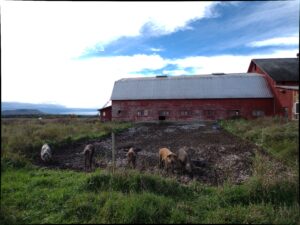
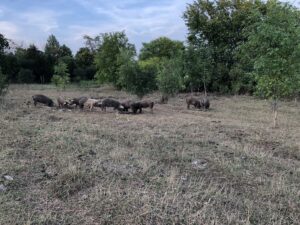
The Barn group was raised in a confined area with no grass (500Sq feet per pig) and administered with our custom non-GMO grain mix twice a day; the Pasture group was splitted in 2 and rotated on paddocks in a pasture field. Each group was administered with the same amount and type of grain we used for the Barn group.
Every day we weighted the amount of feed given to each group using a portable hanging scale and 5 gallon buckets. Feed test

Each group included 5 pigs, counterbalanced for gender and initial weight, for a total of 15 pigs (Tab 1).
The experimental research lasted for the 90 days prior to the day of slaughtering.
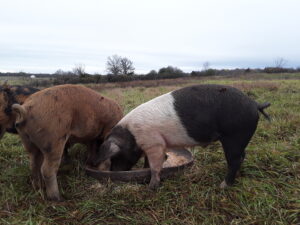
PASTURE MANAGEMENT
The total area grazed by the animals was 5 acres each and each group grazed 5 different paddocks ranging from 2700 to 10000 square feet, depending on the vegetation and time of the year. On average pigs were rotated every 11 days.
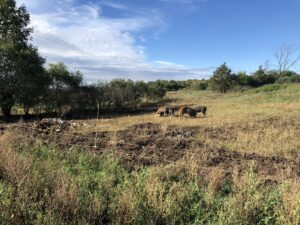
Rotations were determined based on the amount of biomass available in the paddocks and growth pattern. Once pigs were moved a cover crop was planted were soil was left bare. Each paddocks was delineated by a two strand electrified wire fence. Pigs in each paddock had access to shade, natural shelter (trees), and a water trough.
Samples of forage were collected the day pigs were introduced in the paddocks, using a one square foot quadrant. Each of them was weighted and labelled with the number of corresponding sq ft that were collected; then each sample was frozen until the day of shipping to the lab (Dairy One Forage Lab). forage test
Every week/10 days we took measures of length (from in between the ears and the start of the tail) and girth to determine the weight of the animals using the formula (length2 X girth) / 400.
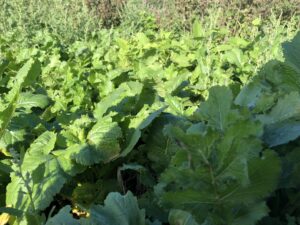
At the end of the 90 days, 2 pigs from each group was sent to the slaughterhouse to determine the exact weight.
The study originally aimed to compare pig size in three groups, pasture vs non pasture vs improved pasture group. Weekly measures of length and girth size were taken for 15 pigs using a measure tape. Other measurement included size of the paddocks and weight of grains, using a 5 gallon bucket and a hanging portable scale. The grain was weighed every day, twice a day. Paddocks were made of polywire and connected to an electric fencer in the barn. Every time pigs were rotated in a new paddock a sample of the grass in order to determine forage energy, proteins and yield for the whole paddock.
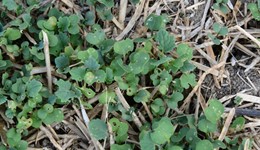
Two additional crops (turnips and alfalfa) were established in a pasture that was originally planned to be an "improved" pasture (Pasture+ group). Alfalfa was broadcasted on April 23rd at a rate of 40 lbs/acre and turnips were broadcasted on June 7th at the rate of 25 lbs/Acre. They were both broadcasted by hand and they had a great emergence of seedlings in the beginning. However, they didn't grow as hoped for different reasons. Turnips suffered of a heavy insect pressure (flea beetle) during the first couple weeks of growth and the were out-competed by weeds over the next couple weeks.
Turnips seeded on other areas of the farms didn't suffer so badly by the presence of the beetle. Alfalfa grew up well in the first couple month but it suffered the extreme hot weather in June and lack of water and didn't produce a great yield. The effect of weather affected greatly the experimental design of the study but not the outcome of the project.
For these reasons the "improved pasture" was considered as normal pasture, since the nutrient content wasn't different compared to the "non improved" pasture. Here below, the graphic 1 shows the difference in average weight between the two groups.
The weight in the pasture group was higher than the confined group throughout the entire duration of the trial with the highest difference in weight (25 lbs) during the week prior to slaughter (Graph 1 & Table 1). If we split the pasture group into the 2 different subgroups (pasture+ and pasture) we can see that the Pasture+ group outperformed the pasture group (Graph 2). This might be due to the higher intake of grass (Tab 3); each pig on Pasture+ ate on average 454 lbs of grass (expressed in dry matter) compared to 282 lbs of grass in the Pasture group. We can see a higher availability of forage in Pasture+ throughout the entire duration of the experiment (Graph 3). This lead on average to a higher intake of energy (Table 4) and protein (Table 5), and to a better growth rate.
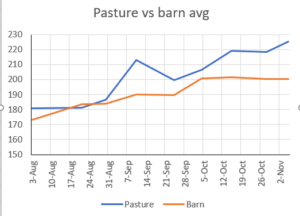
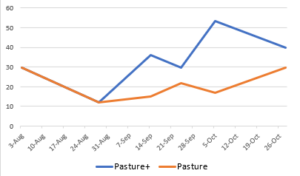
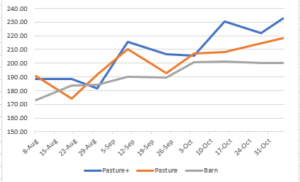
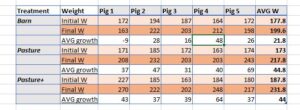
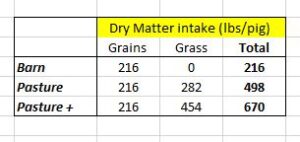


The energy intake was calculated in terms of Metabolizable Energy (ME) which equals to gross feed energy minus energy lost in the faeces, urine
and gases. ME from the grass was added to the ME in the grains; both were provided by the Dairy One test lab. On average, each pig from group Pasture+ had a total intake of 759 Mcal calculated from the beginning to the end of the trial, compared to 595 Mcal in group Pasture and 324 Mcal in the control group. These values might be overestimated due to the fact that the energy values provided by the lab refer to energy assimilated by a ruminant which has a higher efficiency compared to pigs. In general, we could still say that pigs raised on pasture, potentially, have access to an extra source of energy which can be used for growth.
The protein intake values have a similar pattern to the energy ones; each pig from group Pasture+ had a total intake of 97 lbs of protein compared to 71 in group Pasture and 29 lbs in the barn group. Protein were expressed in terms of crude protein, which is the total protein in the sample including true protein and non-protein nitrogen. Crude protein, as ME for energy, can overestimate the amount of actual protein available to the animals because it's a measure of the total nitrogen, an indirect indicator of the protein content. We can still observe though as the pigs raised in group Pasture+ had access to a larger amount of protein and therefore this could explain the higher weight measure. This hypothesis was strengthened by looking at the actual hanging weights sent by the slaughterhouse which are the following:
Pasture+: 243, 208
Pasture: 194, 192
Barn: 189, 190.
These data don't show any difference in weight between the group Pasture and the confined group which is unexpected considering the difference in energy and protein intake. Pasture+ and Barn group have a substantial difference in terms of weight which suggests the opposite in what seen in the comparison between the other 2 groups.
It is important to remember that the weight comes from an indirect measure and that the method chosen in this study was not accurate enough to catch the difference in weights between groups for the extreme difficulty in having a consistent method of measurement.
The difference between the weights provided by the slaughterhouse on November 8th, then converted in live weights and the measures taken from the field on November 5th varies from 19 lbs to 92 lbs.
The size of the pigs were monitored throughout the whole duration of the experiment. Pigs raised on pasture gained on average more weight compared to pigs raised confined, according to the measure taken with the tape. However, the measured weight doesn't catch precisely enough the actual weight of the animals measured at slaughtering.
This research, despite the great variability in the results, can be a good starting point for further in depth analysis on pig grazing with a few adjustments for optimal results: a good protocol and more advanced tools to measure precisely the live weight and the adjustment of the forage values, so that they can be used for non ruminant animals.
The main advantage of having pigs on pasture was the reduction of costs associated with manure spreading and time spent on cleaning pens in the barn. This allowed the farmers to spent more time on other projects. Also, pasture productivity increased due to rotational grazing. Some of the paddocks were grazed again with sheep later in the season.
Areas that were digged by pigs offered a optimal environment for growing cover crops and other perennial grass, thank to the ideal soil preparation performed by the animals.
Forage tests gave a great indication of the amount of nutrient supplemented by the pasture, including elements essential to pig growth such as phosphorus, calcium, lysin, proteins and energy content. Another parameter essential for meat quality is the % of oil in the forage which will be accounted for pasture rotations next year and will be fundamental in the production of cured meat.
Education & Outreach Activities and Participation Summary
Participation Summary:
We provided tours to more than 100 people over the course of 4 months, showing them how we manage pigs on pasture and the importance of good farming practices that affect animal and soil health.
We trained 2 people at the farm on how to manage pig rotations and how to establish cover crops.
Learning Outcomes
The project highlighted several positive aspects of raising pigs outdoor. First, we notice a change in behaviour of animals raised on pasture compared animals raised inside. Outdoor pigs showed a more active behaviour due to foraging, digging and interacting. This resulted in a better body condition and better health. For these reasons, farmers gained more awareness on the importance of raising pigs on pasture and also improved their ability to manage pasture properly, especially timing of rotations which is a key element in this kind of practice.
Farmers gained awereness on the positive and negative impacts that pigs can have on soil health which is highly dependent on speed of rotations, season of the year and weather.
Farmers gained knowledge on cover crop and specifically on crop establishment, importance of seeding techniques and the choice of right cover crop for the right purpose.
Project Outcomes
The project brought greater awareness on the importance of raising pigs on pasture and increased our skills in terms of drove management. Timing of rotations and response of the soil to animal grazing were the two keys components of this project and were both investigated more in depth thank to the project. Other benefits derived from the experiment were related to manure management. We spent less time in cleaning and spreading manure with our tractor, which lead to less money used for gas, maintenance and more time spent with the animals. We achieved better growth rates without additional feed and our pastures were cut without the need of any machinery.
We felt accomplished with our management of the pigs cause we were aware that what we were doing was positive for us, for the animal, for the environment and finally on the community.
Overall, the study's approach was good. The only thing we could have changed is the way pig weight was measured because the method was too rough and imprecise. We would benefit greatly from the purchase of a livestock scale that would give more accurate results and a better understanding of the effects pasture have on pigs. We found trends that can be useful to answer our question but we could produce more accurate results in the future. We are going to keep studying this topic next year since the project showed a benefit in raising pigs outdoor and we would like to quantify more precisely the advantage of including pasture in the diet.
Another issue we had with our study was related to the weather. We planned at the beginning to have an improved pasture in the study, with additional crops (alfalfa and turnips) in the pasture stand. Unfortunately, the scorching hot we had in july didn't allow a good growth of the plants and by time the pigs were in the pasture these plants were to small to be considered as an additional source of energy. Alfalfa proved to be not the best choice for grazing pigs since it's too sensitive to pigs and doesn't seem to be liked so much. Turnips can still be incorporated in the mix next year, since we had good results in other pastures at the farm where they were seeded as cover crop.
Other pig farmers will benefit from this study. More and more farms are trying to raise pigs on pasture and there is the need to explore more the effect of this management on the soil and the possible solutions that can be adopted to succeed. We made good connections over the course of the past summer with several farmers in Vermont that are raising pigs outdoor and they showed a great interest in knowing more about rotations and crops that can be used to improve the energy content of the forage. In the next months, the farm is planning to create a coalition of Vermont farmers that use these practices to raise pigs on pasture and we will discuss more in depth the results that this study highlighted.